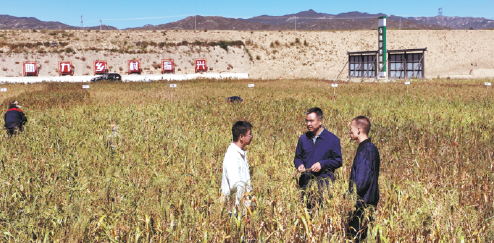Winemakers embracing technology
Updated: 2023-05-05

Daixian county produces one of the best millets in China, ensuring the high quality of its yellow wine. [Photo provided to China Daily]
Characteristic industries strategy encourages brewers to update techniques while preserving ancient recipes
Yanmenguan, a strategic pass of the Great Wall, is the historical landmark of Daixian county in North China's Shanxi province.
Even mentioning this place can help people, including those who are not familiar with Shanxi's geography, get an idea of where this county is.
As one of the most important strongholds along the Great Wall, Yanmenguan is a household name for its frequent references in ancient documents, poems and novels. It is also closely associated with many conflicts and exchanges between the farming Han people to the south of the wall and the nomads in the north.
This place is also associated with a famed beverage – yellow wine. According to local history documents, one of the first references of the drink was in the early Song Dynasty (960-1279).
One of the county's history books said that a military force led by the famed Song Dynasty general Yang Jiye was stationed at Yanmenguan. Each time they were dispatched to defensive operations in the north, local resident would present them with homemade yellow wine, expecting their victorious return. Since then, presenting yellow wine to warriors has become a local tradition.
Yellow wine is made from grain with a fermenting technique that is low in alcohol and high in nutrition. This variety of beverage is unique to China, with a history of more than a millennium.
In Daixian, yellow wine has been made using millet as its main ingredient. Located at 38 degrees north latitude and boasting loess soil, the county is said to have produced one of the best millets in China, thus ensuring the high quality of its yellow wine.
For many centuries, Daixian's yellow wine has been produced mostly by small mills and even households. In the context of today's fierce competition, Daixian's yellow wine industry sustains growth and prospers in the domestic market.
When talking about the industry's success, local insiders and officials said the time-honored production techniques, which feature the strictest standard for quality control, are key.
The glamor and vitality of the old techniques were endorsed by Shanxi's cultural heritage authorities when they included them in the provincial list for intangible cultural heritage protection. They said the techniques are flourishing because they are well preserved and developing thanks to their use by local industrialists.
Gao Guixi, 90, is the founder of local producer Guixi Yellow Wine and is the fourth-generation inheritor of the ancient fermenting techniques.
"The centuries-old techniques are the most precious assets for the industry," Gao said.
"I've been in the industry for more than five decades and experienced ups and downs in my business.
"Every time when we survived and continued to grow, we knew it is the core value of 'quality is the lifeline', which is a tradition embodied in the ancient techniques, that has worked," Gao said.
The industry is also playing a significant role in the local economy as it continues to bring revenue and jobs to residents, as well as business opportunities to local entrepreneurs, according to Zhu Xiaodong, Party secretary of the city of Xinzhou. The county of Daixian is a part of Xinzhou.
This economic role was recognized by Shanxi's authorities as it was included in the provincial list of characteristic towns for local specialty industries in 2022.
The government of Shanxi announced its first batch of 10 characteristic towns in September 2022.
Developing towns with characteristic industries is a new strategy in Shanxi, which aims to create economic engines that accelerate high-quality industrial growth locally.
Local entrepreneurs have realized that the listing of Daixian as a provincial-level characteristic town is a great opportunity for the wine industry's growth, in terms of increasing the influence of local products, strengthening local enterprises' innovation and expanding marketing channels.
Many of them have big plans to expand and upgrade.
Yanmenwang Wine Industry is a yellow wine producer established in Daixian in 2022. It recently began construction of a huge project with a total investment of 6.6 billion yuan ($953 million).
According to Zhang Hongbin, an executive in charge of the construction, it will be a facility integrating production and yellow wine-related tourism.
"In addition to a yellow wine production plant with a designed annual output of 100,000 metric tons, the facility will also include a museum, a yellow wine experiencing park and a hotel," Zhang said.
The executive added that, the company's production will highlight both ancient technique preservation and modernization.
"Ancient techniques will still be used to ensure the authenticity of Daixian yellow wine," Zhang said. "But these will be upgraded with intelligent and automatic production technologies for boosting efficiency and quality control."
He said the production plant is scheduled to begin operation in September.
Gao Ruilin, the third son of Gao Guixi and the current boss of Guixi Yellow Wine, has a similar approach to Zhang.
For instance, his company has used digitalized temperature control technology in the company's fermentation plant.
"Modern technologies like this are helpful in stabilizing production processes and controlling quality," he said. "The traditional things are not only preserved, but they advance with the times."
Wang Liqiang contributed to this story.



